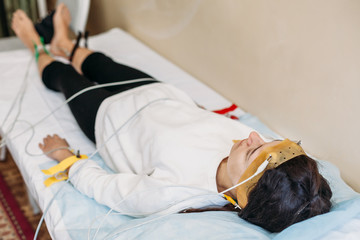Sleep Study Bangalore Helps You identify Sleep Issues for Better Living
Just How a Rest Study Can Change Your Sleep Patterns: Insights and Services Available
A rest study offers as a necessary tool for people seeking to understand and boost their sleep patterns. It supplies a detailed analysis of rest habits and possible conditions. By evaluating numerous metrics, health care specialists can determine underlying concerns that disrupt corrective rest. This process not just help in medical diagnosis yet also establishes the stage for tailored therapy strategies. What insights might a sleep research study disclose about your own rest habits?
Comprehending Rest Researches: What to Anticipate
When individuals get ready for a rest research, they frequently question what the experience will certainly entail. These researches, typically conducted in a rest facility, aim to keep an eye on numerous physiological parameters throughout rest. Upon arrival, participants are welcomed by trained professionals who lead them through the process. The atmosphere is made to be comfy, permitting a natural sleep experience. Participants may be asked to complete surveys concerning their rest habits and case history, which helps in the evaluation.
As the night proceeds, sensors are connected to the body to track mind waves, heart price, and breathing patterns. While the arrangement might really feel unusual, the goal is to gather exact information on the person's sleep patterns. The entire procedure is non-invasive and poses no risk to the individual. Inevitably, the information gathered during the sleep study is crucial for diagnosing prospective rest problems and creating effective therapy strategies.
Common Rest Disorders Identified Through Sleep Researches
Rest researches play an important role in recognizing different rest problems that can significantly affect a person's health and well-being. Common disorders discovered through these studies include obstructive rest apnea, identified by repeated interruptions in breathing during sleep, leading to fragmented sleep patterns. An additional common condition is sleep problems, which includes difficulty dropping or staying asleep, usually leading to daytime exhaustion and damaged performance. Troubled legs syndrome (RLS) is additionally often observed, creating uneasy experiences in the legs and an unmanageable urge to relocate them at night. Narcolepsy, a neurological problem that impacts sleep-wake cycles, is another severe condition recognized in sleep researches, resulting in too much daytime sleepiness and abrupt sleep strikes. Finally, parasomnias, which incorporate abnormal habits throughout sleep, such as sleepwalking or evening terrors, are likewise noted. Early recognition of these problems can assist in timely treatment and enhance overall rest high quality.
The Refine of a Sleep Study: From Prep Work to Outcomes
The procedure of a sleep study may seem challenging, it is a methodical and structured technique created to collect crucial information about a person's rest patterns. Originally, a doctor carries out a detailed evaluation, talking about sleep history and symptoms with the client. This assessment helps determine the particular focus of the research study.
Preparation usually entails standards on rest health and medicine changes before the research study. Individuals might be instructed to prevent high levels of caffeine and alcohol to ensure precise results. On the night of the research, electrodes and sensors are put to check mind task, heart price, breathing, and activities throughout rest.
The information accumulated is thoroughly examined by sleep specialists, who identify any kind of patterns or irregularities indicative of rest disorders. Following this evaluation, a follow-up appointment is set up to talk about the findings and possible therapy choices customized to the individual's needs, promoting improved rest high quality.

Sorts Of Rest Studies: In-Lab vs. Home Rest Examinations
2 main types of sleep researches exist: in-lab research studies and home sleep examinations, each accommodating different demands and scenarios. In-lab studies typically take place in a rest clinic where people are kept an eye on overnight by medical care professionals. This method enables comprehensive data collection on numerous sleep criteria, such as brain task, oxygen levels, and heart rate. Patients are commonly connected to numerous sensors, supplying detailed understandings into their sleep problems, including rest apnea and narcolepsy.
Conversely, home rest examinations provide an easier option for people who like to conduct analyses in their own setting. These portable tools keep an eye on essential metrics like air flow, oxygen saturation, and snoring. While home examinations are less detailed than in-lab research studies, they offer as a useful remedy for identifying usual sleep conditions. Inevitably, the option in between these two kinds of rest researches relies on individual choices, clinical needs, and the seriousness of sleep-related concerns.
Interpreting Your Sleep Research Study Outcomes: Trick Metrics Clarified
Understanding the results of a sleep research study is crucial for patients seeking understandings right into their rest wellness. Trick metrics generally examined in rest researches consist of the Apnea-Hypopnea Index (AHI), which gauges the variety of apneas and hypopneas per hour of rest. AHI worths help determine the seriousness of sleep apnea, with higher scores suggesting extra significant issues. Another essential metric is the total bedtime (TST), which shows the general duration of sleep during the research study. Sleep efficiency, the ratio of time spent asleep to time invested in bed, is additionally essential; greater percents suggest better sleep quality. Furthermore, the percentage of sleep invested in various phases-- light, deep, and rapid eye movement-- supplies understandings into sleep architecture. Understanding these metrics equips patients with the expertise required to discuss their sleep patterns with health care suppliers, leading the way for notified decisions about their rest wellness.
Treatment Choices and Suggestions Based Upon Your Rest Research
When a rest research study reveals issues such as sleep apnea or various other rest conditions, my site different therapy alternatives and referrals appear to improve overall rest health and wellness. For obstructive rest apnea, continual favorable respiratory tract pressure (CPAP) treatment is generally suggested, giving a steady stream of air to maintain respiratory tracts open throughout rest. Oral appliances may be suggested for mild to modest cases, rearranging the jaw to prevent respiratory tract obstruction.
In situations of sleeplessness, cognitive behavior modification for sleeplessness (CBT-I) is typically recommended, concentrating on behavior modifications and assumed patterns that disrupt sleep. In addition, lifestyle modifications such as weight loss, regular exercise, and preventing alcohol or high levels of caffeine before bedtime may improve rest top quality.

Building Healthy Rest Habits: Tips for Better Relax
Structure healthy sleep behaviors is important for attaining restorative rest. Establishing a regular sleep routine, restricting display time before bed, and producing a comfy Home Page rest environment can greatly boost rest quality. These methods serve as fundamental actions for individuals seeking far better sleep results.
Develop a Rest Regimen
Establishing a constant rest regimen is necessary for advertising healthy and balanced rest habits and enhancing overall wellness. Sleep Study Bangalore. A routine sleep schedule, where people go to sleep and awaken at the very same time daily, reinforces the body's all-natural body clocks. This predictability aids regulate the sleep-wake cycle, leading to improved sleep quality. Creating a calming pre-sleep ritual, such as reading or exercising leisure strategies, can signify the body that it is time to relax. Furthermore, enhancing the sleep atmosphere-- by maintaining a comfortable temperature, reducing sound, and making certain darkness-- can better sustain restful rest. By prioritizing these techniques, people can cultivate a sustainable sleep routine that cultivates restorative sleep and adds to much better mental and physical health
Limitation Display Time
As individuals increasingly count on screens for amusement and communication, restricting display time before bed has ended up being important for advertising better sleep. Research study shows that direct exposure to blue light produced by tools such as tablets, smartphones, and computer systems can disrupt the manufacturing of melatonin, the hormonal agent liable for controling sleep. Experts recommend transforming off displays at the very least one hour before going to bed to improve sleep quality. Participating in different activities, such as reading a book or practicing relaxation strategies, can help individuals prepare and unwind for rest. By consciously minimizing display time, individuals can cultivate much healthier rest patterns, resulting in improved total wellness and boosted daytime alertness. Prioritizing this aspect of sleep health is vital for long-term health and wellness.
Develop a Rest Sanctuary
Producing a sleep haven can greatly boost a person's capacity to achieve relaxed sleep. This atmosphere ought to focus on convenience and serenity, integrating components that promote leisure. An appropriate mattress and cushions are necessary, as they directly effect rest top quality. Additionally, the space must be dark, silent, and cool; utilizing blackout curtains and white noise equipments can facilitate this environment. Personalizing the area with relaxing colors and scents, such as lavender, can better boost leisure. Minimizing clutter also adds to a serene atmosphere, enabling for psychological clearness - Sleep Study Bangalore. By attentively developing a sleep haven, individuals can cultivate healthier sleep practices and create a constant regimen, inevitably resulting in boosted overall health and corrective rest
Often Asked Inquiries
How Long Does It Take to See Improvements After a Rest Research study?
Improvements after a rest research study can vary, yet several people begin to notice positive changes within a few weeks. Constant follow-up and adherence to recommended treatments play vital roles in achieving optimal outcomes.

Can Children Undergo Sleep Studies, and How Are They Different?
Yes, youngsters can go through rest researches, which vary from grown-up studies in monitoring methods and equipment. Pediatric evaluations commonly include child-friendly settings and may include parent involvement to ensure convenience and exact results.
Are Sleep Studies Covered by Insurance Coverage, and What Are the Costs?
Rest studies can be covered by insurance policy, depending upon the policy and medical requirement. Expenses differ commonly, ranging from $300 to $3,000, influenced by the sort of research and place of the facility.
What Lifestyle Changes Can Boost the Performance of Sleep Study Outcomes?

Implementing constant rest routines, reducing caffeine intake, producing a calming bedtime routine, and preserving a comfortable sleep atmosphere can see it here considerably boost the performance of rest research study results, advertising far better sleep quality and general wellness.
Exactly how Commonly Should I Repeat a Rest Study for Ongoing Issues?
Individuals experiencing continuous sleep problems must consider repeating a sleep study each to 2 years, or as recommended by health care professionals, to check changes and readjust treatment strategies effectively based upon their advancing rest patterns. (Sleep Study Bangalore)
Sleep studies play a crucial duty in recognizing different sleep problems that can considerably affect a person's wellness and health. Usual problems detected with these research studies consist of obstructive rest apnea, identified by repeated interruptions in breathing throughout rest, leading to fragmented rest patterns. When a sleep research discloses issues such as rest apnea or other rest problems, numerous treatment choices and suggestions come to be available to boost general sleep health. Establishing a consistent sleep routine, restricting screen time prior to bed, and developing a comfy rest setting can greatly enhance rest top quality. In addition, maximizing the rest atmosphere-- by preserving a comfortable temperature, lowering sound, and making certain darkness-- can additionally support relaxing sleep.